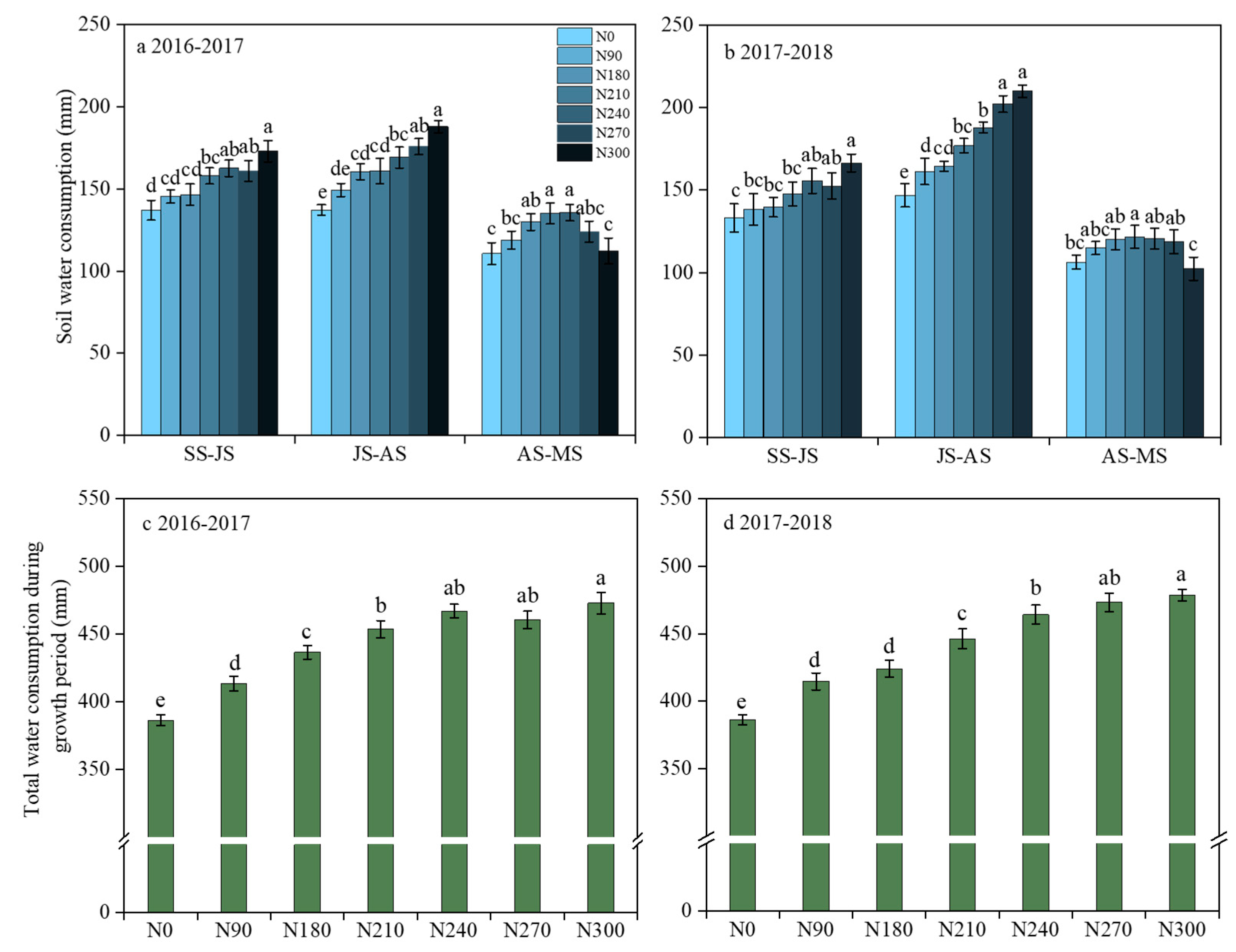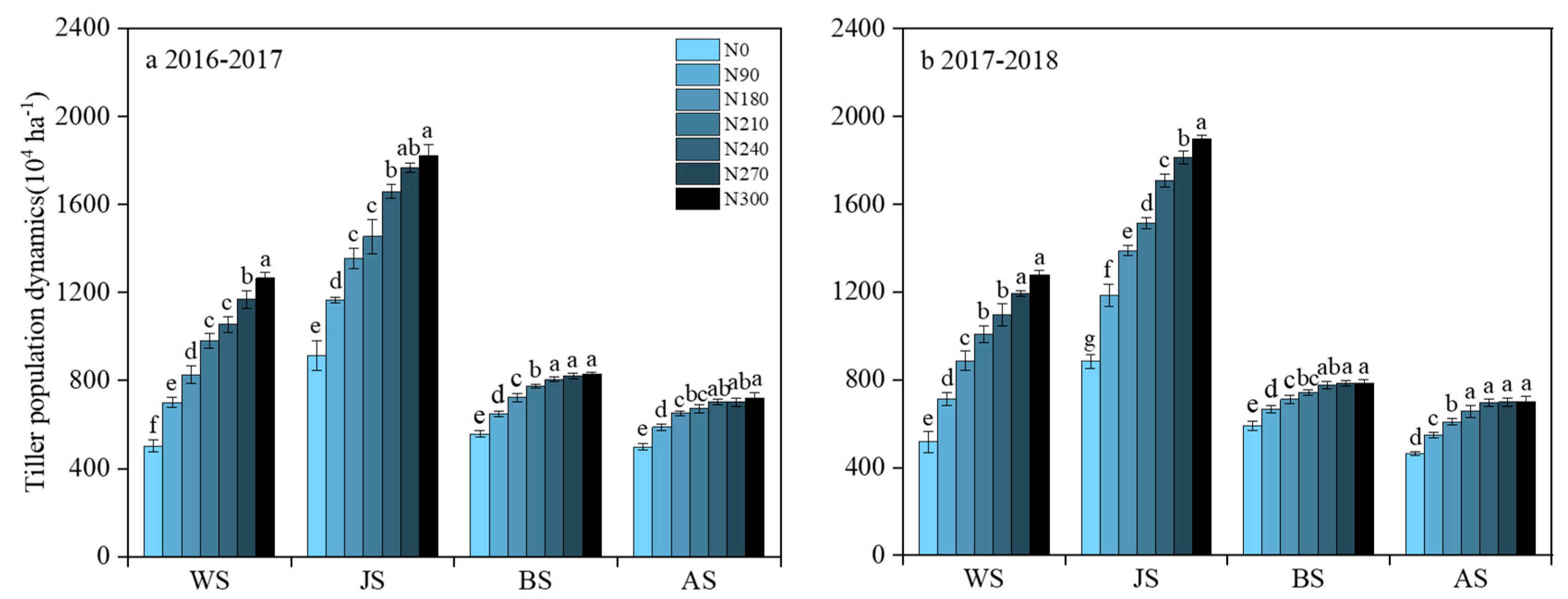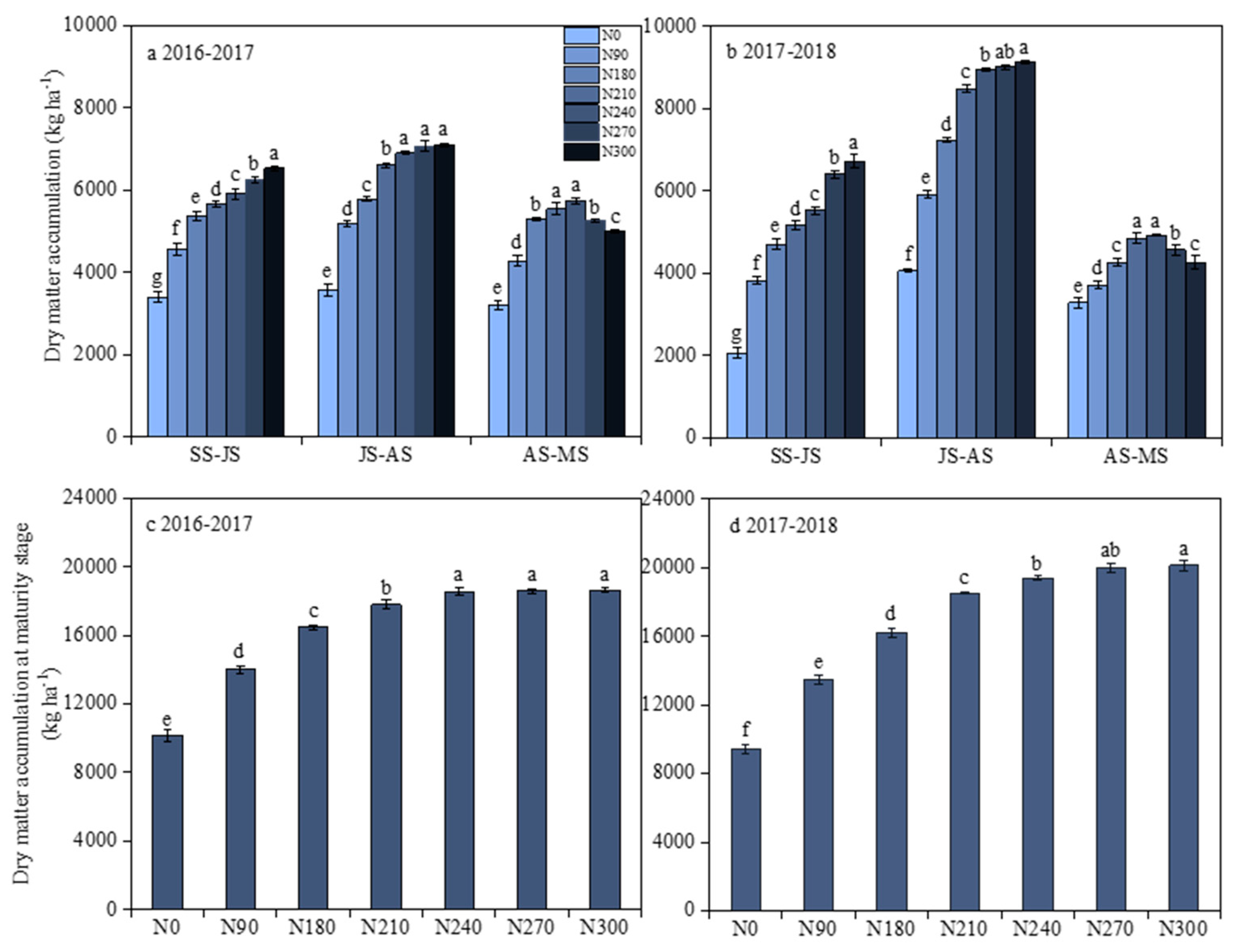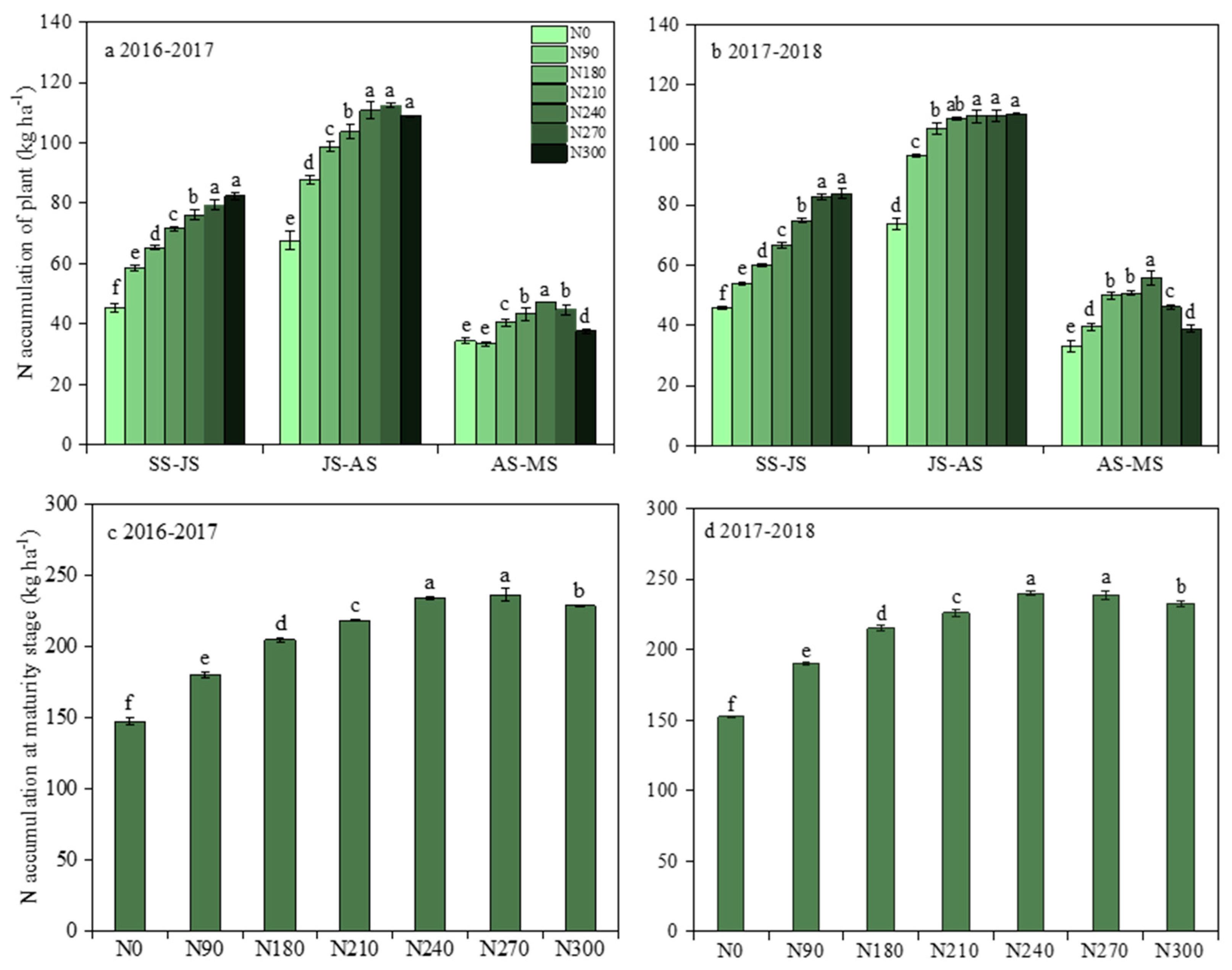Effect of Soil Water and Nutrient Uptake on Nitrogen Use Efficiency, and Yield of Winter Wheat
Abstract
1. Introduction
2. Materials and Methods
2.1. Experimental Site
2.2. Experimental Design
2.3. Soil Water Consumption
2.4. Evapotranspiration
2.5. Plant Nitrogen
2.6. Grain Yield and Composition
2.7. Net Income
2.8. Relative Index Calculation
2.9. Statistical Analysis
3. Results
3.1. Soil Water Consumption
3.2. Tiller Population Dynamics
3.3. Dry Matter Accumulation
3.4. Nitrogen Accumulation and Translocation
3.5. Yield and Water Use Efficiency
3.6. Nitrogen Partial Factor Productivity
3.7. Correlation Analysis among Soil Water Consumption, Nitrogen Accumulation, and Translocation Yield
3.8. Soil Water Consumption of Nitrogen Accumulation, and Yield
3.9. Finding Optimal N-Application Rates
4. Discussion
4.1. Effects of Nitrogen Application on Material Accumulation
4.2. Soil Water Consumption and Nutrient Utilization
4.3. Yield and Comprehensive Benefit
5. Conclusions
Author Contributions
Funding
Data Availability Statement
Conflicts of Interest
References
- Noor, H.; Shah, A.A.; Ding, P.; Ren, A.; Sun, M.; Gao, Z. Long-Term Nutrient Cycle inImproved Grain Yield of Dryland Winter Wheat (Triticum aestivum L.) under Hydrological Process of PlantEcosystem Distribution in the LoessPlateau of China. Plants 2023, 12, 2369. [Google Scholar] [CrossRef] [PubMed]
- FAO. 2019. Available online: https://www.fao.org/faostat/en/#data/QC (accessed on 21 July 2021).
- Raji, V.R.; Packialakshmi, S. Assessing the wastewater pollutants retaining for a soil aquifer treatment using batch column experiments. Civ. Eng. J. 2022, 8, 1482–1491. [Google Scholar] [CrossRef]
- Zheng, B.; Zhang, X.; Wang, Q.; Li, W.; Huang, M.; Zhou, Q.; Cai, J.; Wang, X.; Cao, W.; Dai, T.; et al. Increasing plant density improves grain yield, protein quality and nitrogen agronomic efficiency of soft wheat cultivars with reduced nitrogen rate. Field Crops Res. 2019, 267, 4–8. [Google Scholar] [CrossRef]
- Cui, Z.; Zhang, H.; Chen, X.; Zhang, C.; Ma, W.; Huang, C.; Zhang, W.; Mi, G.; Miao, Y.; Li, X.; et al. Pursuing sustainable productivity with millions of smallholder farmers. Nature 2018, 555, 363–366. [Google Scholar] [CrossRef] [PubMed]
- Ju, X.-T.; Xing, G.-X.; Chen, X.-P.; Zhang, S.-L.; Zhang, L.-J.; Liu, X.-J.; Cui, Z.-L.; Yin, B.; Christie, P.; Zhu, Z.-L.; et al. Reducing environmental risk by improving N management in intensive Chinese agricultural systems. Proc. Natl. Acad. Sci. USA 2018, 106, 3041–3046. [Google Scholar] [CrossRef] [PubMed]
- Spiertz, J. Nitrogen, sustainable agriculture and food security. A review. Agron. Sustain. Dev. 2010, 30, 43–55. [Google Scholar] [CrossRef]
- Xu, H.-C.; Dai, X.-L.; Chu, J.-P.; Wang, Y.-C.; Yin, L.-J.; Ma, X.; Dong, S.; He, M.-R. Integrated management strategy for improving the grain yield and nitrogen-use efficiency of winter wheat. J. Integr. Agric. 2018, 17, 315–327. [Google Scholar] [CrossRef]
- Zhang, X.; Davidson, E.A.; Mauzerall, D.L.; Searchinger, T.D.; Dumas, P.; Shen, Y. Managing nitrogen for sustainable development. Nature 2015, 528, 51–59. [Google Scholar] [CrossRef] [PubMed]
- Naruoka, Y.; Talbert, L.E.; Lanning, S.P.; Blake, N.K.; Martin, J.M.; Sherman, J.D. Identification of quantitative trait loci for productive tiller number and its relationship to agronomic traits in spring wheat. Theor. Appl. Genet. 2011, 123, 1043–1053. [Google Scholar] [CrossRef]
- Wang, Z.; Liu, Y.; Shi, H.; Mo, H.; Wu, F.; Lin, Y.; Gao, S.; Wang, J.; Wei, Y.; Liu, C.; et al. Identification and validation of novel low-tiller number QTL in common wheat. Theor. Appl. Genet. 2016, 129, 603–612. [Google Scholar] [CrossRef]
- Ercoli, L.; Lulli, L.; Mariotti, M.; Masoni, A.; Arduini, I. Post-anthesis dry matter and nitrogen dynamics in durum wheat as affected by nitrogen supply and soil water availability. Eur. J. Agron. 2008, 28, 138–147. [Google Scholar] [CrossRef]
- Si, Z.; Zain, M.; Mehmood, F.; Wang, G.; Gao, Y.; Duan, A. Effects of nitrogen application rate and irrigation regime on growth, yield, and water-nitrogen use efficiency of drip-irrigated winter wheat in the North China Plain. Agric. Water Manag. 2020, 231, 106002. [Google Scholar] [CrossRef]
- Noor, H.; Noor, F.; Liang, L.T.; Ding, P.; Sun, M.; Gao, Z. Nitrogen fertilization and precipitation affected Wheat (Triticum aestivum L.) in dryland the Loess Plateau of South Shanxi, China. Heliyon 2023, 9, e18177. [Google Scholar] [CrossRef]
- Noor, H.; Yan, Z.; Sun, P.; Zhang, L.; Ding, P.; Li, L.; Ren, A.; Sun, M.; Gao, Z. Effects of Nitrogen on Photosynthetic Produc-tivity and Yield Quality of Wheat (Triticum aestivum L.). Agronomy 2023, 13, 1448. [Google Scholar] [CrossRef]
- Noor, H.; Ding, P.; Ren, A.; Sun, M.; Gao, Z. Effects of Nitrogen Fertilizer on Photosynthetic Characteristics and Yield. Agronomy 2023, 13, 1550. [Google Scholar] [CrossRef]
- Mbuthia, L.W.; Acosta-Martínez, V.; DeBruyn, J.; Schaeffer, S.; Tyler, D.; Odoi, E.; Mpheshea, M.; Walker, F.; Eash, N. Long term tillage, cover crop, and fertilization effects on microbial community structure, activity: Implications for soil quality. Soil. Bio Biochem. 2015, 89, 24–34. [Google Scholar] [CrossRef]
- Przulj, N.; Momčilović, V. Dry matter and nitrogen accumulation and use in spring barley. Plant Soil. Environ. 2003, 49, 36–47. [Google Scholar] [CrossRef]
- Yang, X.; Lu, Y.; Ding, Y.; Yin, X.; Raza, S.; Tong, Y. Optimising nitrogen fertilisation: A key to improving nitrogen-use efficiency and minimising nitrate leaching losses in an intensive wheat/maize rotation (2008–2014). Field Crops Res. 2017, 206, 1–10. [Google Scholar] [CrossRef]
- Mon, J.; Bronson, K.F.; Hunsaker, D.J.; Thorp, K.R.; White, J.W.; French, A.N. Interactive effects of nitrogen fertilization and irrigation on grain yield, canopy temperature, and nitrogen use efficiency in overhead sprinkler-irrigated durum wheat. Field Crops Res. 2016, 191, 54–65. [Google Scholar] [CrossRef]
- Norse, D.; Ju, X. Environmental costs of China’s food security. Agric. Ecosyst. Environ. 2015, 209, 5–14. [Google Scholar] [CrossRef]
- Ekeleme, A.C.; Ekwueme, B.N.; Agunwamba, J.C. Modeling contaminant transport of nitrate in soil column. Emerg. Sci. J. 2021, 5, 471–485. [Google Scholar] [CrossRef]
- Bastos, L.M.; Carciochi, W.; Lollato, R.P.; Jaenisch, B.R.; Rezende, C.R.; Schwalbert, R.; Prasad, P.V.; Zhang, G.; Fritz, A.K.; Foster, C.; et al. Winter Wheat Yield Response to Plant Density as a Function of Yield Environment and Tillering Potential: A Review and Field Studies. Front. Plant Sci. 2020, 11, 54. [Google Scholar] [CrossRef] [PubMed]
- Liu, H.; Wang, Z.; Yu, R.; Li, F.; Li, K.; Cao, H.; Yang, N.; Li, M.; Dai, J.; Zan, Y.; et al. Optimal nitrogen input for higher efficiency and lower environmental impacts of winter wheat production in China. Agric. Ecosyst. Environ. 2016, 224, 1–11. [Google Scholar] [CrossRef]
- Jiang, L.; Zhang, Y.; Zhu, Y.; Zhao, L. Effects of Nitrogen Application on Dry Matter Accumulation, Transport and Yield in Different Wheat Varieties. Crops 2019, 5, 151–158. [Google Scholar] [CrossRef]
- Demotes-Mainard, S.; Jeuffroy, M.H. Effects of nitrogen and radiation on dry matter and nitrogen accumulation in the spike of winter wheat. Field Crops Res. 2004, 87, 221–233. [Google Scholar] [CrossRef]
- Jha, S.K.; Ramatshaba, T.S.; Wang, G.; Liang, Y.; Liu, H.; Gao, Y.; Duan, A. Response of growth, yield and water use efficiency of winter wheat to different irrigation methods and scheduling in North China Plain. Agric. Water Manag. 2019, 217, 292–302. [Google Scholar] [CrossRef]
- Ding, P.; Noor, H.; Shah, A.A.; Yan, Z.; Sun, P.; Zhang, L.; Li, L.; Jun, X.; Sun, M.; Elansary, H.O.; et al. Nutrient Cycling and Nitrogen Management Impact of Sowing Method and Soil Water Consumption on Yield Nitrogen Utilization in Dryland Wheat (Triticum aestivum L.). Agronomy 2023, 13, 1528. [Google Scholar] [CrossRef]
- Jin-Peng, L.I.; Zhang, Z.; Yao, C.S.; Liu, Y.; Zhang, Y. Improving winter wheat grain yield and water-/nitrogen-use efficiency by optimizing the micro-sprinkling irrigation amount and nitrogen application rate. J. Integr. Agric. 2021, 20, 606–621. [Google Scholar]
- Liu, W.; Wang, J.; Wang, C.; Ma, G.; Wei, Q.; Lu, H.; Xie, Y.; Ma, D.; Kang, G. Root Growth, Water and Nitrogen Use Efficiencies in Winter Wheat Under Different Irrigation and Nitrogen Regimes in North China Plain. Front. Plant Sci. 2018, 9, 1798. [Google Scholar] [CrossRef]
- Wang, J.; Liu, W.; Dang, T. Responses of soil water balance and precipitation storage efficiency to increased fertilizer application in winter wheat. Plant Soil 2011, 347, 41–51. [Google Scholar] [CrossRef]
- Noor, H.; Sun, M.; Algwaiz, H.I.M.; Sher, A.; Fiaz, S.; Attia, K.A.; Wani, S.H.; AlKahtani, M.D.F.; Al Husnain, L.; Lin, W.; et al. Chlorophyll fluorescence and grain filling characteristic of wheat (Triticum aestivum L.) in response to nitrogen application level. Mol. Biol. Rep. 2022, 49, 7157–7172. [Google Scholar] [CrossRef] [PubMed]
- Wang, H.; Zhang, Y.; Chen, A.; Liu, H.; Zhai, L.; Lei, B.; Ren, T. An optimal regional nitrogen application threshold for wheat in the North China Plain considering yield and environmental effects. Field Crops Res. 2017, 207, 52–61. [Google Scholar] [CrossRef]
- Wang, L.; Palta, J.A.; Chen, W.; Chen, Y.; Deng, X. Nitrogen fertilization improved water-use efficiency of winter wheat through increasing water use during vegetative rather than grain filling. Agric. Water Manag. 2018, 197, 41–53. [Google Scholar] [CrossRef]
- Noor, H.; Min, S.; Khan, S.; Lin, W.; Ren, A.; Yu, S.; Ullah, S.; Yang, Z.; Gao, Z. Different sowing methods increase the yield and quality of soil water consumption of dryland Winter wheat on the loess plateau of China. Appl. Ecol. Environ. Res. 2020, 18, 8285–8308. [Google Scholar] [CrossRef]
- Sun, M.; Gao, Z.; Zhao, W.; Deng, L.; Deng, Y.; Zhao, H.; Ren, A.; Li, G.; Yang, Z. Effect of subsoiling in fallow period on soil water storage and grain protein accumulation of dryland wheat and its regulatory effect by nitrogen application. PLoS ONE 2013, 8, e75191. [Google Scholar] [CrossRef]
- Pask, A.; Sylvester-Bradley, R.; Jamieson, P.; Foulkes, M. Quantifying how winter wheat crops accumulate and use nitrogen reserves during growth. Field Crops Res. 2012, 126, 104–118. [Google Scholar] [CrossRef]
- Hu, C.L.; Ding, M.; Qu, C.; Sadras, V.; Yang, X.; Zhang, S.L. Yield and water use efficiency of wheat in the Loess Plateau: Responses to root pruning and defoliation. Field Crops Res. 2015, 179, 6–11. [Google Scholar] [CrossRef]
- Zörb, C.; Ludewig, U.; Hawkesford, M.J. Perspective on wheat yield and quality with reduced nitrogen supply. Trends Plant Sci. 2018, 23, 1029–1037. [Google Scholar] [CrossRef]
- Qu, B.; Feng, F.; Di, J.; Noor, H. Root morphology and physiological of their relationship with nitrogen uptake in wheat (Triticum aestivum L.). Heliyon 2024, 10, e29283. [Google Scholar] [CrossRef]





| Year | Organic Matter (g ha−1) | Alkali-Hydrolysis N (mg·kg−1) | Available Phosphorus (mg ha−1) | Available Potassium (mg ha−1) |
|---|---|---|---|---|
| 2016–2017 | 12.07 | 36.42 | 16.28 | 218.76 |
| 2017–2018 | 12.59 | 42.50 | 21.99 | 180.34 |
| Year | Period | Precipitation (mm) | Daily Mean Temperature (°C) | Total Accumulated Temperature (°C d) |
|---|---|---|---|---|
| 2016–2017 | S–J | 35.3 | 3.2 | 654.7 |
| J–B | 47.5 | 11.9 | 226.1 | |
| B–A | 27.1 | 18.1 | 344.7 | |
| A–M | 44.3 | 20.9 | 753.1 | |
| 2017–2018 | S–J | 48.9 | 3.7 | 732.8 |
| J–B | 20.7 | 13.2 | 304.5 | |
| B–A | 22.7 | 18.6 | 371.4 | |
| A–M | 10.7 | 21.8 | 871.6 |
| Seed and Fertilizers Inputs (Yuan kg−1) | Other Inputs (Yuan ha−1) | ||||||
|---|---|---|---|---|---|---|---|
| N Fertilizer | P2O5 | K2O | Seed | Irrigation | Tillage | Sowing | Reaping |
| 4.35 | 5 | 8 | 4.8 | 1200 | 750 | 600 | 750 |
| Treatment | Dry Matter Translocation before Anthesis | Dry Matter Accumulation after Anthesis | |||
|---|---|---|---|---|---|
| Amount | CG (%) | Amount | CG (%) | ||
| 2016–2017 | N0 | 1426.6 d | 30.84 c | 3200.1 e | 69.16 a |
| N90 | 2115.8 c | 33.04 bc | 4286.0 d | 66.96 ab | |
| N180 | 2561.8 b | 32.59 c | 5298.5 b | 67.41 a | |
| N210 | 2738.7 b | 33.07 bc | 5544.9 a | 66.93 ab | |
| N240 | 3185.4 a | 35.65 b | 5749.9 a | 64.35 b | |
| N270 | 3315.9 a | 38.68 a | 5255.2 b | 61.32 c | |
| N300 | 3322.4 a | 39.87 a | 5009.3 c | 60.13 c | |
| 2017–2018 | N0 | 1198.0 e | 26.72 d | 3285.8 e | 73.28 a |
| N90 | 2878.3 d | 43.69 bc | 3709.9 d | 56.31 bc | |
| N180 | 3352.5 c | 44.00 bc | 4265.1 c | 56.00 bc | |
| N210 | 3544.7 bc | 42.22 c | 4851.9 a | 57.78 b | |
| N240 | 3704.3 ab | 42.90 c | 4930.0 a | 57.10 b | |
| N270 | 3798.4 a | 45.42 ab | 4564.9 b | 54.58 cd | |
| N300 | 3823.8 a | 47.31 a | 4260.3 c | 52.69 d | |
| Treatment | (NTBA) | (NAAA) | (NAG) (kg ha−1) | |||
|---|---|---|---|---|---|---|
| A (kg ha−1) | CG (%) | A (kg ha−1) | CG (%) | |||
| 2016–2017 | N0 | 90.85 f | 72.47 d | 34.52 e | 27.53 a | 125.37 f |
| N90 | 120.59 e | 78.25 b | 33.52 e | 21.75 c | 154.11 e | |
| N180 | 139.20 d | 77.41 bc | 40.62 c | 22.59 bc | 179.82 d | |
| N210 | 145.96 c | 77.07 bc | 43.43 b | 22.93 bc | 189.39 c | |
| N240 | 154.32 a | 76.56 c | 47.24 a | 23.44 b | 201.56 a | |
| N270 | 151.17 b | 77.16 bc | 44.76 b | 22.84 bc | 195.93 b | |
| N300 | 150.98 b | 80.04 a | 37.65 d | 19.96 d | 188.63 c | |
| 2017–2018 | N0 | 84.22 g | 71.90 c | 32.91 e | 28.10 ab | 117.13 f |
| N90 | 106.23 f | 72.92 c | 39.44 d | 27.07 b | 145.67 e | |
| N180 | 120.22 e | 70.70 c | 49.81 b | 29.30 a | 170.02 d | |
| N210 | 129.49 d | 71.86 c | 50.70 b | 28.14 ab | 180.19 c | |
| N240 | 135.97 c | 70.91 c | 55.78 a | 29.08 a | 191.75 a | |
| N270 | 141.57 b | 75.45 b | 46.06 c | 24.55 c | 187.63 b | |
| N300 | 146.89 a | 79.12 a | 38.75 d | 20.87 d | 185.64 b | |
| Treatment | Spike Number (×104 ha−1) | Grain Number per Spike | 1000-Grain Weight (g) | Yield (kg ha−1) | WUE (kg ha−1 mm−1) | |
|---|---|---|---|---|---|---|
| 2016–2017 | N0 | 482.0 d | 29.10 d | 43.42 a | 4626.6 f | 11.97 f |
| N90 | 573.3 c | 32.34 c | 41.43 b | 6401.8 e | 15.48 e | |
| N180 | 634.2 b | 34.50 bc | 40.13 c | 7860.3 d | 18.00 cd | |
| N210 | 669.5 ab | 35.11 ab | 39.35 d | 8283.6 c | 18.26 bc | |
| N240 | 688.6 a | 36.68 a | 39.61 cd | 8935.4 a | 19.13 a | |
| N270 | 695.2 a | 36.22 ab | 38.38 e | 8571.1 b | 18.61 ab | |
| N300 | 702.8 a | 36.69 a | 37.07 f | 8331.8 bc | 17.62 d | |
| 2017–2018 | N0 | 459.1 e | 28.23 c | 45.22 a | 4483.3 e | 11.61 e |
| N90 | 535.9 d | 31.92 b | 43.12 b | 6588.2 d | 15.89 d | |
| N180 | 594.0 c | 33.91 a | 42.16 c | 7617.6 c | 17.96 b | |
| N210 | 642.6 b | 34.69 a | 41.30 d | 8396.6 ab | 18.82 a | |
| N240 | 673.8 ab | 35.21 a | 40.99 d | 8634.3 a | 18.60 a | |
| N270 | 687.8 a | 34.95 a | 39.57 e | 8363.3 ab | 17.67 b | |
| N300 | 680.9 a | 35.28 a | 38.68 f | 8084.1 b | 16.89 c | |
| Treatment | NPFP (kg kg−1) | NUE (%) | NUE (kg kg−1) | |
|---|---|---|---|---|
| 2016–2017 | N0 | —— | —— | —— |
| N90 | 71.13 a | 2.00 a | 35.55 c | |
| N180 | 43.67 b | 1.14 b | 38.39 a | |
| N210 | 39.45 c | 1.04 c | 37.88 ab | |
| N240 | 37.23 d | 0.98 d | 38.14 ab | |
| N270 | 31.74 e | 0.88 e | 36.23 bc | |
| N300 | 27.77 f | 0.76 f | 36.40 b | |
| 2017–2018 | N0 | —— | —— | —— |
| N90 | 73.20 a | 2.11 a | 34.74 c | |
| N180 | 42.32 b | 1.20 b | 35.40 bc | |
| N210 | 39.98 c | 1.08 c | 37.15 a | |
| N240 | 35.98 d | 1.00 d | 35.97 b | |
| N270 | 30.98 e | 0.88 e | 35.07 bc | |
| N300 | 26.95 f | 0.78 f | 34.74 c | |
| Index | DMASS-JS | DMAJS-AS | DMTPre | DMAPost | Yield |
|---|---|---|---|---|---|
| SWCSS-JS | 0.916 ** | 0.896 ** | 0.860 ** | 0.670 | 0.791 * |
| SWCJS-AS | —— | 0.916 ** | 0.903 ** | 0.670 | 0.814 * |
| SWCAS-MS | —— | —— | 0.440 | 0.758 * | 0.608 |
| SWCT | 0.983 ** | 0.988 ** | 0.968 ** | 0.845 ** | 0.934 ** |
| Index | NASS-JS | NAJS-AS | NTPre | NAPost |
|---|---|---|---|---|
| SWCSS-JS | 0.947 ** | 0.822 * | 0.886 ** | 0.413 |
| SWCJS-AS | —— | 0.862 ** | 0.916 ** | 0.416 |
| SWCAS-MS | —— | —— | 0.432 | 0.892 ** |
| SWCT | 0.991 ** | 0.951 ** | 0.983 ** | 0.636 |
| Index | Nmin (kg ha−1) | NN-max (kg ha−1) | Nmax (kg ha−1) |
|---|---|---|---|
| Yield | 187 | 276 | 365 |
| NI | 186 | 258 | 330 |
| WUE | 140 | 222 | 304 |
| NUE | 95 | 197 | 299 |
Disclaimer/Publisher’s Note: The statements, opinions and data contained in all publications are solely those of the individual author(s) and contributor(s) and not of MDPI and/or the editor(s). MDPI and/or the editor(s) disclaim responsibility for any injury to people or property resulting from any ideas, methods, instructions or products referred to in the content. |
© 2024 by the authors. Licensee MDPI, Basel, Switzerland. This article is an open access article distributed under the terms and conditions of the Creative Commons Attribution (CC BY) license (https://creativecommons.org/licenses/by/4.0/).
Share and Cite
Li, X.; Noor, H.; Noor, F.; Ding, P.; Sun, M.; Gao, Z. Effect of Soil Water and Nutrient Uptake on Nitrogen Use Efficiency, and Yield of Winter Wheat. Agronomy 2024, 14, 819. https://doi.org/10.3390/agronomy14040819
Li X, Noor H, Noor F, Ding P, Sun M, Gao Z. Effect of Soil Water and Nutrient Uptake on Nitrogen Use Efficiency, and Yield of Winter Wheat. Agronomy. 2024; 14(4):819. https://doi.org/10.3390/agronomy14040819
Chicago/Turabian StyleLi, Xiaofen, Hafeez Noor, Fida Noor, Pengcheng Ding, Min Sun, and Zhiqiang Gao. 2024. "Effect of Soil Water and Nutrient Uptake on Nitrogen Use Efficiency, and Yield of Winter Wheat" Agronomy 14, no. 4: 819. https://doi.org/10.3390/agronomy14040819
APA StyleLi, X., Noor, H., Noor, F., Ding, P., Sun, M., & Gao, Z. (2024). Effect of Soil Water and Nutrient Uptake on Nitrogen Use Efficiency, and Yield of Winter Wheat. Agronomy, 14(4), 819. https://doi.org/10.3390/agronomy14040819







